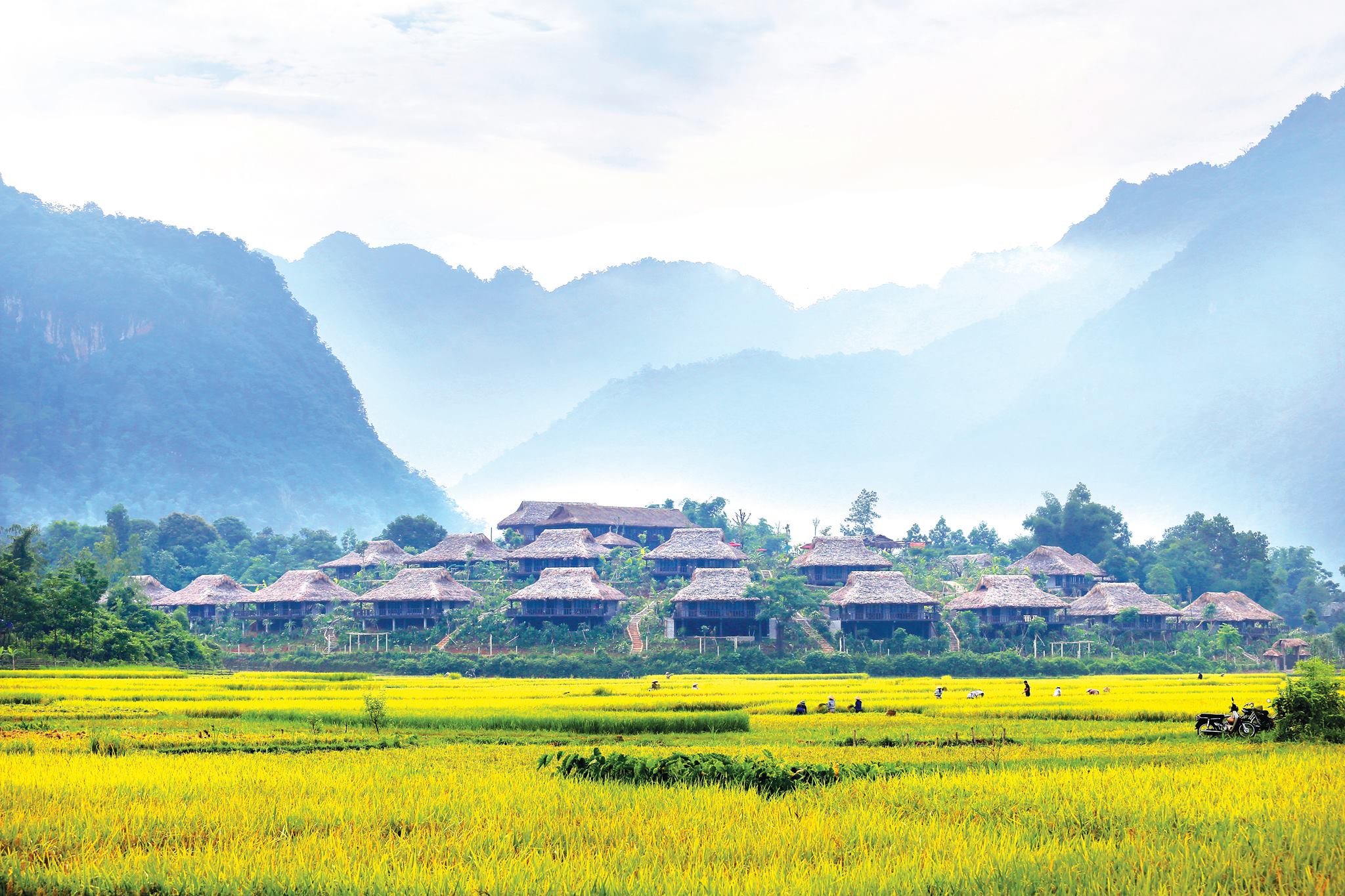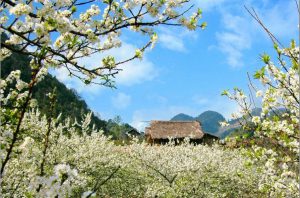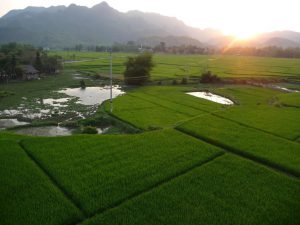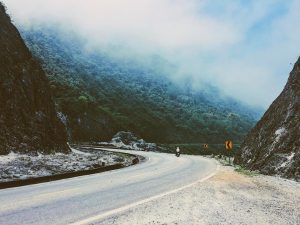Vattanac Golf Resort's East Course has been honored as the Best Golf Course in Cambodia for 2024 by the World Golf Awards.
Mai Chau weather – A comprehensive guide


The first thing to hit visitors to Mai Chau is often the vivid meld of colours that highlight the particular picture-perfect scene for which the region is known. An often-blue sky crowns the tops of dark green mountains, which skim the edges of light green and gold rice paddies, where villagers wearing multicoloured brocades harvest and plant their precious crop. Having been a largely-unknown farming community until relatively recently, villagers in this rural district of Hoa Binh Province have been benefitting from a modern tourist interest in a beautiful section of Northern Vietnam.
Day trips to Mai Chau from Hanoi and overnight stays in the traditional stilt houses of the Thai hill tribe have grown in popularity due to the region’s improved road connections with the capital, offering a worthwhile alternative to the sometimes-crowded and quite distant Sapa. Mai Chau is four to five hours from Hanoi, along with incredible lowland and mountain paths, offering stunning views of Vietnam at its verdant best. Being relatively close to the capital, Mai Chau’s weather is similar to that of Hanoi’s; hot and wet summers, cold and grey winters and the beautifully cool and dry spell in between. However, differences in altitude between Mai Chau and Hanoi bring about differences in weather and visitors should be prepared for these small fluctuations, as Mai Chau deserves to be experienced at its best. This is our comprehensive guide to the weather in Mai Chau.
Mai Chau in Spring
Late February to Mid-May
Being of such natural green beauty, the four months of spring in Mai Chau showcases the region at its most rewarding, with clear days, low humidity, a cooling breeze and the blooming of Mai Chau’s iconic flowers.
Temperature
The end of the Vietnamese New Year (Tet) in February brings Mai Chau out in full splendour. As the colourful decorations that adorn the stilt houses are put away for the year, the sun gradually comes out and turns Mai Chau’s valleys into buzzing hubs of activity. Average temperatures climb from about 18°C to 27°C (67°F to 80°F) through late February to the middle of May as the sun emerges from the winter clouds. The warmth of spring in May Chau can be felt both in the temperature and in the smiles and hospitality of locals as they happily prepare for another productive rice harvest.
Rainfall
Rain during the start of spring is almost non-existent. Averages of 24mm of precipitation mean the coolness of a trek during this season is also blessed with a crisp dryness. This is at least the case for February and March, but rainfall triples in April to 78mm, which then triples again over the course of a month to become 250mm in May. Days in May are littered with sporadic rain, where clear skies can become crowded with clouds and heavy lightning storms are not uncommon over the mountainous areas during this dress rehearsal for the wet season.
Sunshine Hours
The sporadic nature of Mai Chau weather means that May, while the fourth wettest month, is also one of the sunniest. Deluges of rain from the fast-moving clouds are often short, making way for the sun after just a couple of hours in a lot of cases. During the 6 hours of sun that Mai Chau enjoys daily, visitors are often treated to the best of the valley’s sun-dappled views, while rainstorms bring an exciting thrill and great opportunities for dramatic photographs.
In comparison, the start of Mau Chau’s spring can be a bit dull, with the 3 hours of sunshine per day in February and March casting many shadows over the region. April is probably the best time to visit Mai Chau for the 5 hours of sunshine and relatively low rainfall.

Mai Chau – What to see and do in Spring
As with all of Vietnam’s rice-producing districts, Mai Chau’s true wonder reveals itself in May when the rice harvest offers expansive views of vast golden fields swaying gently in the breeze, tended to by the local Thai farmers and their buffalo. Even before the harvest, rice fields are blessed with a light green as farmers plant the baby rice after the New Year at the end of February.
Another fantastic bonus of the Mai Chau spring weather is the introduction of varieties of blooming flowers. The region is known countrywide by photos of the white plum blossom, a very romantic sight that steals the hearts of visitors to the region during the early months of spring. Lac Village is one of the best places to see the intense bloom; the trees here often look snow-covered due to the vivacity with which the flowers bloom.
Mai Chau in Summer
Late May to Mid-September
The clouds congregating towards the middle of May have Mai Chau in their grasp by the time summer is in full swing. The rainy season is at its peak and the heat is more intense, but there are still experiences to be sought out.
Temperature
The intensity of the weather in Mai Chau during summer is notably different from that of its twinned rice terrace destination, Sapa. Averages here are quite a bit higher, reaching a fairly uniform at 28°C (82°F) from the end of May to the middle of September. Still, the high altitude and windy valleys of the region mean that this is a good deal lower than a lot of other places in Northern Vietnam, in particular, Hanoi, which can average well into the mid-30s. Treks can become a little more draining during these months and nights can be a sweaty experience, but the right clothes can make all the difference.
Rainfall
After a 40mm dip in rainfall between May and June, as the last of the rice is being plucked from the ground, the wet season reaches its full intensity and rainfall equates to between 320 and 340mm from July through September. Trekking and cycling become dangerous activities on the slippery mountain roads and the clouds create theatrical scenes above the mountains. Days that include rain reach their annual peak in August, with 21 out of 31 days featuring abundant downpours.
Sunshine Hours
Generally, the behaviour of clouds during the summer in Mai Chau is just as erratic as in the spring. Rain comes in very strong droves, but overall torrents are short and sharp, leaving the sky clear for much of the day. Daily sunshine hours of 5 and 6 are a feature of the Mai Chau weather during summer, as they usually are throughout the year, except for a persistently cloudy patch in February and March. Rainstorms roll in rapidly over the mountains and steeped rice terraces, so make sure you have somewhere to seek refuge if you head to Mai Chau during this time.

Mai Chau – What to see and do in Summer
While the more active attractions such as trekking and cycling become arduous slogs due to the heat and constant threat of rain, paying a visit to any of Mai Chau’s magnificent waterfalls could be a great idea to see the impressive rush of water that turns falls like Go Lao and Dai Yem into scenes of incredible natural power.
There are no better refuges to seek from the rain and heat than the caves that dot the hillsides of Mai Chau. Chieu Cave, Mo Luong Cave and Pieng Kem Grotto are just some of the places around the ancient region that feature complete rain coverage and a natural cooling system throughout. They take a few steps to climb, but the relief you will feel upon entering these indoor forests of stalagmites is palpable.
Mai Chau in Autumn
Late September to Late November
The rains that have swept through Mai Chau by the end of September have left a new sprouting life in their wake. Rice is replanted, different flowers reach their bloom and the more relaxed heat and rain make for ideal trekking.
Temperature
The heat climbs down from its lofty heights from September to November, reeling back the 28°C of summer to a more tolerable 24°C (75°F) in October and 21°C (70°F) in November. These are both ideal activity temperatures and so a lot of time during autumn is spent outside making the most of the perfect Mai Chau weather. Nights during November average around 17°C (62°F), meaning peaceful and comfortable nights in Thai stilt houses are an attractive possibility.
Rainfall
The obligatory runs for shelter during the summer in Mai Chau are a thing of the past in autumn, as monthly rainfall plummets like the waterfalls from 323mm during September to just 30mm in November. The tenfold decrease in precipitation makes for some very dry days and the number of days in which rain makes an appearance falls from 16 to 7 over Mai Chau’s autumn.
Sunshine Hours
The trend of consistent 5 or 6 hours of sunshine per day continues throughout autumn in Mai Chau, where flash floods of rain are much less common and clouds have a more docile nature when congregating above the tall limestone ridgeline. Blue skies are a common sight and that brings out another season of flowers blooming throughout the district.

Mai Chau – What to see and do in Autumn
As the best time to visit Mai Chau, there are lots of activities to do and things to see during autumn as the elements are all in your favour. The more energetic activities of trekking and cycling become very popular between September and November, with various day tours to Mai Chau from Hanoi descending on the area to check out the flower blossoms. Farmers commence the second yearly rice harvest around areas such as Pu Luong Nature Reserve and the various walkways surrounding Poom Coong Village.
Mai Chau in Winter
December to Late February
Sapa in winter is famous for the snow that occasionally blankets the barren rice fields, drawing huge crowds of Vietnamese people longing for a winter wonderland. Nothing of that kind hits Mai Chau; winters are generally a little chilly and bleak, though very dry.
Temperature
While shorts and a t-shirt may be a viable option in the South of Vietnam, the north, and hill regions like Mai Chau in particular, get relatively much lower temperatures. Still, an average of 17°C (67°F) between December and February is the acceptable weather for lots of activities in Mai Chau, but the windiness of the valley will mean that it feels quite a bit colder. Nighttime lows in January can reach 12°C (53°F), which is frankly Antarctic to Vietnamese people, meaning you should have plenty of space and will enjoy off-season prices for travel and accommodation.
Rainfall
Though not an ideal time to go for the temperature, the minimal rainfall during a Mai Chau winter is a big advantage. The 6mm of rain that falls in January is staggeringly low compared to the 340mm of August, and the days in which rain is present in December falls to a very meagre 5. You won’t need much in the way of rainproof gear for the Mai Chau weather in winter, and if you can withstand the mild chill, then you could realistically spend a lot of time outdoors.
Sunshine Hours
Yet another reason to be outside, at least for the start of winter, is the blue sky that remains present for 5 hours of the day in December. This falls to 4 in January and then 3 in February, so visits to Mai Chau earlier on in the winter would be preferable.

Mai Chau – What to see and do in Winter
The main beauty of Mai Chau is obviously its stunning outdoor scenery, but there are many things to do around the region that allows for more relaxing downtime. Unwinding at the homestay is far from the last resort; the Thai stilt houses that most people sleep in during an overnight trip to Mai Chau are very rustic, but comfortable, with all the modern amenities you should need. Hosts will have a stockpile of blankets for the winter, as well as hot tea and coffee, providing very cosy conditions for a peaceful time in the mountains.
A look around Pac Co Market would suit the winter weather in Mai Chau. This is a weekly Sunday market run by the H’mong hill tribe, which acts as a meeting place for distant friends and family, as well as a place for locals to sell their clothes, food, animals, toys and drinks. Take the opportunity to stock up on warm, traditional and colourful garments sold by the H’mong people, and make sure to haggle for the best price as there most likely won’t be a lot of other customers.
Source: incredibleasiajourneys


